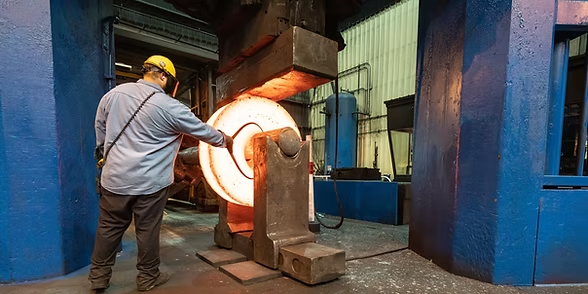Closed die forging, also known as impression die forging, is a precision metal forming process where a heated workpiece is shaped between two pre-machined dies under high pressure. Known for its ability to produce high-strength and near-net-shape components, this process is widely used in industries such as aerospace, automotive, oil & gas, and defence.
Despite its advantages, closed die forging defects can compromise product quality, increase scrap rates, and affect safety and performance. In this blog, we’ll walk you through the most common forging defects and how to prevent those using modern techniques and industry best practices.
Understanding Common Closed Die Forging Defects
To eliminate defects, the first step is understanding what they are. Here are the most common flaws encountered in closed die forging:
1. Laps and Folds
Caused by improper metal flow, leading to overlaps or folds in the material, typically at seams.
2. Cracks
Often the result of excessive stress, low ductility, or improper temperature control during forging.
3. Underfilling
Occurs when the die cavity isn’t fully filled due to insufficient force or poor billet preparation.
4. Flash
Excess metal leaks out of the die, resulting in material waste and additional machining requirements.
5. Surface Defects
These can include pits, scales, and rough finishes due to die wear, contamination, or poor billet cleaning.
Importance of Proper Die Design
Die design is at the heart of any successful closed die forging process. A poorly designed die leads to improper metal flow, underfill, and flash issues.
Best Practices for Die Construction:
- Include adequate draft angles and corner radii for easy material flow.
- Avoid sharp transitions to prevent stress concentrations.
- Use allowances for shrinkage and dimensional tolerance.
- Maintain symmetry to balance pressure distribution.
Mid-section Tip: For precision die design and defect-free forging, many industry leaders trust Millennium Ring. Their advanced forging techniques ensure exceptional accuracy and performance.
Material Selection and Preparation
The quality of raw materials significantly influences forging outcomes. Substandard material can result in internal cracks, inconsistent deformation, and poor mechanical properties.
Best Practices:
- Choose appropriate alloys based on application requirements.
- Maintain consistent chemical composition for predictable results.
- Preheat billets uniformly to avoid thermal gradients.
- Descale and clean billets to eliminate surface impurities.
Optimizing Process Parameters
Precision in process control is critical for minimizing forging defects. Key process variables include:
- Temperature: Ensure proper forging temperature for optimal metal flow and reduced crack risk.
- Deformation Rate: Maintain a consistent and controlled strain rate.
- Lubrication: Adequate lubrication reduces friction, die wear, and improves surface finish.
Use sensors and real-time monitoring tools for consistent control and data tracking across batches.
Tooling & Die Maintenance
Even the best die design won’t perform well without regular maintenance. Die wear can result in dimensional inaccuracies and poor surface quality.
Maintenance Guidelines:
- Use high-quality die steel with excellent wear resistance.
- Conduct periodic inspections and repair worn dies immediately.
- Apply coatings or treatments to extend die life and enhance performance.
- Implement a preventative maintenance schedule.
Simulation & Process Modelling
Simulation software is a game-changer in today’s forging industry. It allows manufacturers to visualize material flow and identify potential flaws before production begins.
Benefits:
- Detect defects virtually before actual forging.
- Optimize die geometry and temperature profiles.
- Reduce waste and the number of physical trial runs.
Skilled Workforce & Process Supervision
Machines alone can’t guarantee quality — trained personnel are essential to manage operations and recognize anomalies.
Key Focus Areas:
- Train operators on machine control, defect recognition, and safety protocols.
- Use digital dashboards and smart sensors for floor monitoring.
- Conduct regular audits and reviews to identify process bottlenecks.
Inspection and Testing
Quality assurance doesn’t end at forging. Post-forging inspection is crucial to confirm product integrity.
Inspection Methods:
- Visual Inspection for surface defects and flash.
- Non-Destructive Testing (NDT) like ultrasonic or dye penetrant testing for internal flaws.
- Dimensional Analysis using gauges or coordinate measuring machines (CMMs).
Continuous batch-level inspections help in detecting trends early and minimizing rework.
Adherence to Industry Standards
Following international forging standards ensures product reliability and regulatory compliance.
Common Standards:
- ASTM and ISO standards for forged components.
- NADCAP compliance for aerospace-grade forgings.
- Internal SOPs aligned with global best practices.
Certifications and audits not only reflect quality but also build trust with customers.
Conclusion: Build Quality from the Ground Up
Preventing closed die forging defects is not about one single fix — it’s about a holistic approach involving:
- Thoughtful die design
- Superior material quality
- Controlled process parameters
- Skilled workforce and supervision
- Ongoing inspection and certification
By partnering with experienced forging specialists like Millennium Ring, manufacturers can produce defect-free components that meet the most demanding industry standards.
Need High-Quality Forging Solutions?
Reach out to Millennium Ring today for industry-leading closed die forging services tailored to your application needs.


